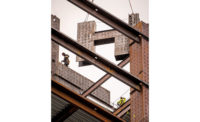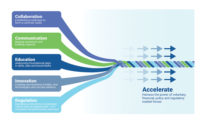Engineers and government agencies along with model building code and standard developers should work together to create a national framework more focused on earthquake resilience and post-quake recovery time, according to a report delivered to Congress last week. While current seismic codes address life safety, the report says stakeholders should also consider re-occupancy and functional recovery time, taking into account the potential impacts to a community as a whole.
The report’s findings were compiled by a committee formed in 2019 by the National Institute of Standards and Technology and the Federal Emergency Management Agency, under the direction of Congress.
“It’s not enough to care only about the performance of individual assets,” says Siamak Sattar, a NIST structural engineer and report co-author. “We have to think about the recovery of a community.”
Ronald O. Hamburger, a senior principal for structures at engineer Simpson Gumpertz & Heger and also a report author, says he has seen a shift in thinking around building recovery, following several recent disasters that devastated communities. Following Hurricane Katrina in 2006, roughly half of the population of New Orleans was displaced or relocated. Ten years later, the city’s population was still 20% below 2006 levels, as many residents never returned to the city.
Quakes represent a risk to almost half of the U.S. population—150 million people—who reside in seismic zones likely to have a damaging quake in the next 50 years, notes the report.
Reshaping Risk Categories
In light of these concerns, the report discusses determining levels of function of buildings and establishing acceptable time schedules for them to remain out of commission. This process could result in reshaping life-safety risk categories established in building codes, says Hamburger.
Hospitals are already in the highest risk category (category IV) under current codes, which would align with high community demand for recovery. However, other building types could vary between their respective level of life safety risk and level of recovery need. A grocery store, for example, could be at a moderate life-safety risk, but have very high importance to community resilience, suggests Hamburger.
High-occupancy buildings can also have varying levels of community demand. “Residential buildings you want useable, otherwise people will leave,” he says. “Office buildings, maybe aren’t as important, if people are able to work at home.”
Developing buildings with recovery in mind could create a need for new recovery-based design criteria for buildings and lifelines, as design parameters could focus more on improving community resilience.
These new considerations would not necessarily require a major overhaul of existing building codes to meet goals for community resilience, says Hamburger. Instead, they could represent an additional set of standards that can be adopted within a jurisdiction’s existing codes, perhaps as an index.
“There’s nothing in the current code that would prevent a team from designing a resilient structure,” he adds.
The report explores designing buildings and infrastructure to meet recovery needs, as well as retrofitting existing buildings. Ryan Kersting, associate principal at Buehler Engineering and chair of the technical panel for the report, says that studies show that the cost of incorporating resiliency criteria into new construction projects is “nominal.”
Examples within the report showed increased project costs of between 1% and 3% on new construction. Retrofitting existing buildings, however, might be constrained in the level of performance that could be achieved and the costs related to those improvements.
To cover costs, beyond requiring building owners and developers to bear the cost burden, jurisdictions could offer grants, tax breaks and other incentives, recommends the report. Siamak says owners of more-resilient buildings could be eligible for lower insurance rates or qualify for pre-approved repair loans.
Path to Implementation
Kersting says he sees “a logical path for implementation, starting with some voluntary options” as jurisdictions learn to implement those resilience options. “As that gets worked out and you understand how you implement the options, then you can start to see that approved, adopted and added to building a code as a new standard,” he adds.
The roadmap is not clear for the committee’s recommendations, as it depends on what Congress does with the report, says Hamburger. For example, Congress could identify a budget that provides research funding for the development of standards. The federal government could also “adopt standards for federal buildings to show this is an appropriate way to do things.”
Until then, “it’s critical for state and local jurisdictions to pick this up now," asserts Kersting. "There are things they can do now within current building codes that will improve recovery time by simply using provisions of the existing building code.”
Designers should take a lead role in pushing for design criteria that consider re-occupancy and functional recovery time, Kersting adds. “Engineers should be talking to their clients about the performance they want," he advises. "Until it’s a mandatory requirement, there should be more conversations about the options” to go beyond life safety.





Post a comment to this article
Report Abusive Comment